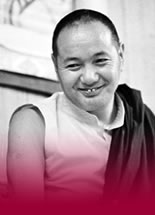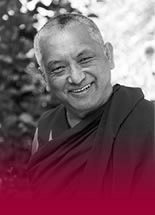Q & A with Robina
22 November, 2021
Venerable Robina:
It has been quite a while since we have corresponded, I hope you are healthy and well.
Regarding the intricately complex maze of decisions, intentions, and actions that I suddenly had insight into a while back – as you suggested, I try very hard not to forget it, and I try to incorporate it into my world. I have actively tried to call up the realization itself as often as I can, and try to place small reminders around me that I will see during my day to help slow me down, and use the dharma to refocus my mind.
The good news is that with the help of the knowledge I gained in that insight, I have at least been able to begin to see some of these negative emotional events as the fruits of some bad karma ripening. I try to embrace that thought and reflect on that as a method to not only help shorten the times of depression, but see them as beneficial in some way.
But when migraines hit, they can sometimes be paired with massive bouts of anxiety and depression that last for a few days. These often knock me off balance in my practice, but I try to get back on target again as soon as I am able. There is certainly no perfection to worry about here!
I am wondering if there is anything you can offer by way of helpful hints to navigate these massive brain chemistry storms (I have come to view the migraines as just that, neurochemical superstorms that overwhelm my brain for a number of days, depending on the severity). I am open to hearing any thoughts you may have, or if the Buddha ever taught about such abnormalities in the brain. Meditation helps, but I am no expert.
Also, I would like to ask a question that I struggle with about holy objects. It is about the idea of treating a physical item with reverence because others have said that it is holy or sacred. Putting aside the idea that we can always offend other people by being ignorant of their beliefs and doing something stupid, my problem is that I have always had an aversion to giving an object the kind of agency that goes along with labelling something holy. These items are just as impermanent as I am, or even a tree in my yard is. Why are they suddenly special? What have they gained to change them structurally? As I said, I do follow what I have been taught, and change has been occurring because of that. But, I find myself feeling as though I am only doing so for my own growth. It gives my mind a point on which to focus its intentions on and a target to pray in supplication towards, but I am unable to bring myself to accept that this item has actually gained some supernatural power that it didn't possess before it was carved into the shape of the Shakyamuni Buddha's likeness. I wrestle with this, and would be grateful if you had any guidance.
Thank you again for your teaching, and your time. I know I have been long winded in this email so I thank you for your patience.
With much love,
V
ANSWER
Happy to hear from you, V.
Those migraines: wow, so intense.
The Buddha mightn’t have much to say about the brain — that’s not his expertise — but he certainly has plenty to say about what suffering is and where it comes from, as you know.
Of course, there’s an intimate relationship between the body and mind. And it’s really hard to navigate this.
One approach is it’s crucial to remember that because we all have attachment to having everything nice – that’s the main energy of attachment! – the moment something such as a headache comes – or any other event that attachment doesn’t want – aversion immediately arises.
The trouble is we just assume that it’s natural to have aversion to the headache or whatever the event might be.
The thing to notice, to analyze, is that the headache is one thing and the aversion is quite another. And the fact is the physical pain is only made much worse by the aversion. It’s quite a revelation to notice that.
And then, of course, for a person who lives with the view of karma, a good way to think about the suffering when it comes is that it’s the fruit of past negativity (just like your happiness is the fruit of past positivity), and have part of your mind try to be glad that you’re cleaning up your karma. The dirt is coming out, as Lama Zopa Rinpoche puts it! This is tough if we’re not used the concept of karma. But it’s powerful if we can do it.
Meanwhile, do everything you can to find methods to fix the problem. Have you thought of a Tibetan doctor? They have a whole different way of analyzing these things
As for holy images. It’s not complicated. We’re creatures of form, aren’t we? You have a dear friend so you take a photo of them and put it in a frame on your mantelpiece to remind you of them. You might admire a musician, so you have a photo of them. This makes sense.
Same here: the photos and paintings and statues of the buddhas are simply reminders of what we can become. We need that!
As for respecting them: that makes sense. Even just a photo of your loved one: if someone threw it on the ground, you’d be offended. It’s only metal and paper, but its meaning is more than that you to, isn’t it? It’s a bit like that.
All the best to you, V,
Robina

